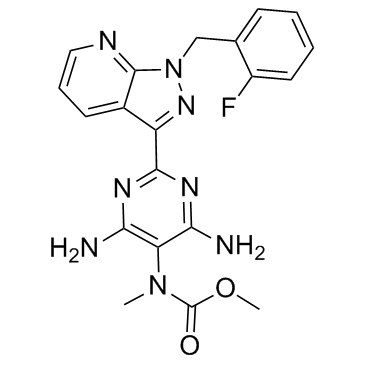625115-55-1
| Name | riociguat |
|---|---|
| Synonyms |
Carbamic acid, N-[4,6-diamino-2-[1-[(2-fluorophenyl)methyl]-1H-pyrazolo[3,4-b]pyridin-3-yl]-5-pyrimidinyl]-N-methyl-, methyl ester
BAY 63-2521 Methyl {4,6-diamino-2-[1-(2-fluorobenzyl)-1H-pyrazolo[3,4-b]pyridin-3-yl]-5-pyrimidinyl}methylcarbamate Adempas Riociguat (JAN/INN) N-[4,6-Diamino-2-[1-[(2-fluorophenyl)methyl]-1H-pyrazolo[3,4-b]pyridin-3-yl]-5-pyrimidinyl]-N-methylcarbamic acid methyl ester Riociguat Methyl N-(4,6-diamino-2-{1-((2-fluorophenyl)methyl)-1H-pyrazolo(3,4-b)pyridin-3-yl}pyrimidin-5-yl)-N-methylcarbamate UNII-RU3FE2Y4XI methyl N-[4,6-diamino-2-[1-[(2-fluorophenyl)methyl]pyrazolo[3,4-b]pyridin-3-yl]pyrimidin-5-yl]-N-methylcarbamate |
| Description | Riociguat is an oral stimulator of soluble guanylate cyclase (sGC) used in the treatment of pulmonary hypertension. |
|---|---|
| Related Catalog | |
| Target |
sGC[1] |
| In Vitro | Riocigua stimulates the recombinant sGC concentration dependently from 0.1 to 100 μM with a two-fold to 73-fold effect by an NO-independent but haem-dependent mechanism[1]. Riociguat inhibits platelet function in washed platelets but not in whole blood, and exerts no direct effects on contractility and relaxation of cardiac myocytes[2]. |
| In Vivo | Riociguat (10 mg/kg/d, p.o.) partially reverses the pulmonary arterial hypertension, the right heart hypertrophy and the structural remodelling of the lung vasculature in chronic treatment of hypoxic mice and MCT-injected rats[1]. |
| Animal Admin | Mice[1] For chronic intervention studies four groups of mice are used: control mice exposed for 35 days to normoxic gas (n=10); mice exposed for 21 days to hypoxic gas (n=10); mice exposed for 35 days to hypoxic gas and who receives the vehicle (2% methylcellulose solution) from day 21 to day 35 (n=10); and mice exposed for 35 days to hypoxic gas and who receives BAY 63-2521 (10 mg/kg) once a day by oral application (n=10) from day 21 to day 35. For continuous measurement of Prvs and cardiac frequency by radiotelemetry, a separate group of mice is exposed for 35 days to hypoxic gas and receives BAY 63-2521 (10 mg/kg) once a day by oral application from day 21 to day 35. In order to investigate vascular reactivity in isolated mouse lungs, an additional two groups of animals are investigated: control mice (n=12) and animals exposed for 21 days to hypoxic conditions (n=12). Rats[1] Rats are randomised for chronic BAY 63-2521 treatment, 21 days after MCT injection. The experimental groups includes rats that receives BAY 63-2521 (10 mg/kg) or vehicle (2% methylcellulose solution) by oral application, once per day. Rats are examined daily and subjected to haemodynamic measurements and histological assessment at day 35. |
| References |
| Density | 1.5±0.1 g/cm3 |
|---|---|
| Boiling Point | 567.2±50.0 °C at 760 mmHg |
| Molecular Formula | C20H19FN8O2 |
| Molecular Weight | 422.416 |
| Flash Point | 296.8±30.1 °C |
| Exact Mass | 422.161499 |
| PSA | 138.80000 |
| LogP | -0.31 |
| Vapour Pressure | 0.0±1.6 mmHg at 25°C |
| Index of Refraction | 1.720 |


